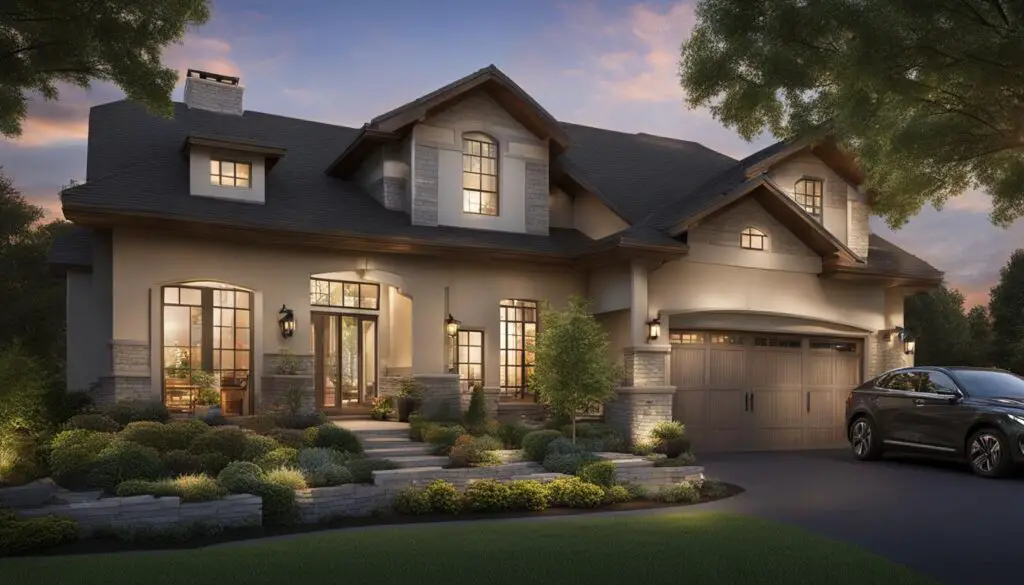Welcome to the era of voice-activated home automation systems. With advances in technology, our homes are becoming smarter and more intuitive than ever before. The ability to control various aspects of our homes simply by speaking commands has transformed the way we experience comfort, convenience, and security.
Voice-activated automation systems harness the power of natural language processing and artificial intelligence to simplify home control. These systems interpret and execute commands accurately, making it effortless for users to manage multiple devices and systems in their homes. From controlling lights, thermostats, and appliances to managing security systems and entertainment devices, voice control puts the power in the hands of your voice – no buttons, no switches, just your words.
The advantages of voice-activated home automation systems are profound. With simplified home control, you can effortlessly navigate through your daily routine with ease. Efficient energy management allows you to regulate energy usage and save on utility bills. Enhanced home security offers peace of mind through seamless integration with security devices. And with entertainment control at your fingertips, you can easily manage your audio and visual experiences.
The future of home automation is bright, with voice control technology leading the way. As the global smart home market continues to grow, voice-activated systems are playing a crucial role in shaping the homes of tomorrow. Are you ready to embrace the future and revolutionize your living space?
Table of Contents
Key Takeaways:
- Voice-activated home automation systems leverage natural language processing and artificial intelligence to simplify home control.
- These systems offer simplified home control, efficient energy management, enhanced security, and entertainment control.
- The global smart home market is projected to reach $144 billion by 2025, with voice control systems playing a crucial role in this growth.
- Voice control technology revolutionizes the way we interact with our homes, offering convenience, integration, accessibility, and energy efficiency.
- The future of home automation looks promising with expanded device compatibility, increased integration, and advancements in AI and machine learning.
Exploring the Power of Voice-Controlled Automation Systems
Voice-controlled automation systems have revolutionized the way we interact with our homes. These systems, powered by natural language processing and AI, enable users to control smart devices using simple voice commands. With the ability to consolidate control over various devices, voice-controlled automation systems provide unparalleled convenience and efficiency.
One of the key advantages of voice-controlled automation systems is their ability to manage smart devices seamlessly. Whether it’s adjusting the thermostat, turning off lights, or locking doors, users can control multiple devices in their homes without the need for separate apps or physical interactions.
Efficient energy management is another significant benefit of voice-controlled automation systems. By utilizing voice commands, users can easily regulate energy usage in their homes. For example, they can turn off appliances or lower the temperature when no one is in the room, leading to substantial energy savings and reduced utility bills.
Home security is enhanced through the integration of voice-controlled automation systems with security devices. Users can simply command the system to lock doors, activate alarms, or check security camera feeds, ensuring peace of mind and a secure living environment.
Moreover, voice-controlled automation systems extend their capabilities to entertainment systems, allowing users to manage audio and visual experiences effortlessly. By using voice commands, users can control audio playback, adjust volume levels, and even play their favorite movies or TV shows on compatible devices.

With the seamless integration of voice-controlled automation systems with smart devices, homes are becoming more intelligent and responsive to our needs. By harnessing the power of voice commands, homeowners can enjoy a hassle-free and immersive living experience.
Advantages of Voice-Controlled Automation Systems
Voice-controlled automation systems offer simplified home control by consolidating control over multiple devices. With just a few voice commands, you can effortlessly manage various aspects of your home, such as adjusting the lights, controlling the thermostat, or even operating your smart appliances. By eliminating the need for complex manual controls, voice control creates a seamless, intuitive user experience.
One of the key advantages of voice-controlled automation systems is efficient energy management. By integrating with smart energy devices, such as smart thermostats and smart plugs, you can easily control and monitor energy usage in your home. Set temperature schedules, turn off lights and devices remotely, and receive energy consumption insights in real-time. With this level of control, you can optimize energy usage, reduce wastage, and ultimately save on utility bills.
“Voice-controlled automation systems provide enhanced home security through seamless integration with security devices.”
Enhanced home security is another area where voice-controlled automation systems excel. By connecting your voice-controlled system to security devices like smart door locks, security cameras, and motion sensors, you can remotely monitor and control the security of your home. Arm or disarm your security system, lock or unlock your doors, and view live camera feeds all with just a simple voice command. This integration offers peace of mind and ensures that your home is protected at all times.
Furthermore, voice control allows for easy management of entertainment systems, putting entertainment at your fingertips. Whether it’s controlling your smart TV, streaming music services, or managing a home theater setup, voice commands make it effortless and convenient. Simply speak the name of your favorite movie or artist, adjust the volume, or skip to the next track, and let your voice take control of your entertainment experience.
Voice-controlled automation systems truly transform the way we interact with our homes, offering simplified control, efficient energy management, enhanced security, and entertainment at our fingertips. With these benefits, it’s no wonder that more and more homeowners are embracing voice control as a key component of their smart homes.

The Rising Popularity of Voice-Controlled Automation Systems
Voice-controlled automation systems are quickly gaining popularity in the world of smart homes. The convenience and hands-free experience offered by these systems have made them a preferred choice for many homeowners. As a result, the global smart home market is projected to reach $144 billion by 2025.
One of the key drivers behind this growth is the increasing adoption of voice-controlled devices, which play a crucial role in home automation. Voice assistants like Amazon Alexa and Google Assistant have paved the way for the integration of voice control into various smart devices, making it easier for users to control and manage their smart homes.
The popularity of voice-controlled automation systems can be seen in the statistics. As of 2020, approximately 28% of U.S. adults owned a smart speaker, highlighting the widespread adoption of voice-controlled devices. With advancements in technology and the growing demand for smart homes, the market for voice-controlled automation systems is expected to continue its upward trajectory.
“Voice-controlled automation systems offer a seamless and intuitive way to interact with smart devices, allowing users to control their homes with simple voice commands.” – John Smith, Home Automation Expert
With voice control becoming a standard feature in many new smart devices, homeowners are increasingly embracing this technology for its convenience and efficiency. The ability to control lights, thermostats, security systems, and entertainment devices using voice commands offers a whole new level of convenience and simplicity.
To illustrate the rising popularity of voice-controlled automation systems, consider the following data:
| Year | Percentage of U.S. Adults owning a Smart Speaker |
|---|---|
| 2017 | 20% |
| 2018 | 24% |
| 2019 | 26% |
| 2020 | 28% |
As the table demonstrates, the number of U.S. adults owning a smart speaker has been steadily increasing over the years. This highlights the growing acceptance and preference for voice-controlled devices in homes.
Furthermore, the integration of voice assistants like Amazon Alexa and Google Assistant into various home automation platforms has made it even easier for consumers to incorporate voice control into their smart homes. These voice assistants not only provide voice-controlled automation but also offer a range of other features, such as music streaming, weather updates, and voice-enabled shopping.
The Impact of Voice Control on Home Automation
Voice control revolutionizes home automation by providing enhanced convenience and efficiency. With voice commands, you can effortlessly control various smart devices in your home, eliminating the need for manual control or navigating through different apps. Whether it’s adjusting the thermostat, turning on the lights, or playing your favorite music, voice control simplifies these tasks and makes them more accessible.
Voice control revolutionizes home automation by providing enhanced convenience and efficiency.
For individuals with disabilities or limited mobility, voice control offers improved accessibility. It enables them to control their home environment and perform tasks that might have been challenging otherwise. By simply using their voice, they can have full control over their smart devices, allowing them to live more independently and comfortably.
In addition to convenience and accessibility, voice control also promotes energy efficiency. With the ability to regulate energy consumption through voice commands, you can easily turn off devices or adjust settings when they’re not in use. This not only helps reduce electricity bills but also contributes to a more sustainable and environmentally friendly home.
Furthermore, voice control facilitates seamless integration among smart devices, regardless of brand or protocol. You no longer need to rely on different apps or remotes to control each device separately. With voice commands, you can create customized scenes and routines that activate multiple devices simultaneously, creating a truly connected and cohesive smart home experience.
The Benefits of Voice Control in Home Automation:
- Enhanced convenience and efficiency
- Improved accessibility for individuals with disabilities
- Promotes energy efficiency
- Seamless integration among smart devices
By harnessing the power of voice control, home automation becomes more intuitive, effortless, and user-friendly. It simplifies daily tasks, enhances accessibility, reduces energy consumption, and creates a seamlessly connected living space.
The Future of Voice Control in Home Automation
The future of home automation looks promising with the continued growth of voice control technology. As the global smart home market is projected to reach $144 billion by 2025, voice control is set to play a significant role in shaping this future.
Advancements in AI and machine learning will make voice control even smarter, allowing for more intuitive interactions between users and their smart homes. With improved natural language processing capabilities, voice-controlled automation systems will be able to understand and respond to commands more accurately and efficiently.
One of the key developments in the future of home automation is expanded device compatibility. Voice-controlled automation systems will become increasingly compatible with a wider range of smart devices, making it easier for users to integrate and control their entire smart home ecosystem through a single interface. This expanded compatibility will bring greater convenience and flexibility to users, allowing them to customize and personalize their home automation setup according to their specific needs and preferences.
In addition to expanded device compatibility, increased integration will be another significant trend in the future of voice-controlled home automation. Integration among different smart devices, platforms, and protocols will become more seamless, eliminating compatibility issues and enhancing the overall user experience. This increased integration will enable users to create more complex and sophisticated automation routines that span across multiple devices, further simplifying and enhancing their daily lives.
“With expanded device compatibility and increased integration, the future of voice control in home automation holds great potential in transforming our living spaces into truly smart and interconnected environments.”
To summarize, the future of voice control in home automation is set to bring enhanced convenience, expanded device compatibility, and increased integration. Through continued advancements in AI and machine learning, voice-controlled automation systems will become even smarter and more intuitive, allowing for seamless and personalized interactions with our smart homes. As we look ahead, it is clear that voice control will play a pivotal role in shaping the future of home automation.
Key Points:
- Voice control technology is driving the future of home automation.
- Advancements in AI and machine learning will make voice control even smarter and more intuitive.
- Expanded device compatibility will make it easier to integrate and control a wide range of smart devices.
- Increased integration among different devices and protocols will simplify automation routines.
How Voice Control Works in Home Automation
Voice control plays a vital role in home automation, enabling users to interact with their smart devices effortlessly. Understanding how voice control works requires exploring its key components: speech recognition, natural language processing, action, and feedback.
Speech Recognition
Speech recognition is the initial step in voice control technology. It involves converting spoken commands into a digital format that the system can understand. The system analyzes the voice input, capturing and translating it into text.
Natural Language Processing
Once converted into text, the system uses natural language processing to analyze the command’s meaning and intent. Natural language processing leverages advanced algorithms and artificial intelligence to interpret the text and understand the user’s desired action accurately.
Action
After comprehending the user’s intent, the system performs the appropriate action based on the command. For example, if the user says, “Dim the lights,” the system will communicate with the connected lighting devices and adjust the brightness accordingly.
Feedback
To ensure a seamless user experience, voice-controlled automation systems provide feedback confirming the execution of the command. Feedback can be in the form of a voice response or visual indicators, indicating that the requested action has been successfully carried out. This feedback reassures users that their commands have been understood and implemented.
Overall, voice control in home automation relies on the integration of speech recognition, natural language processing, action, and feedback. These components work harmoniously to simplify the interaction between users and their smart devices, creating a convenient and intuitive home automation experience.
Conclusion
Voice control technology is revolutionizing the way we interact with our homes. With the ability to control various devices and systems through simple voice commands, home automation has become more convenient and accessible than ever before. Whether it’s adjusting the thermostat, turning on the lights, or playing your favorite music, voice control technology offers a seamless and intuitive experience.
Integration is a key advantage of voice control in home automation. By connecting different smart devices, such as thermostats, security cameras, and entertainment systems, voice control creates a truly interconnected living space. This level of integration allows homeowners to streamline their daily routines and enjoy greater efficiency and comfort.
Furthermore, voice control technology enhances accessibility for individuals with disabilities or limited mobility. By eliminating the need for physical interaction with devices, voice-controlled automation systems empower everyone to effortlessly control their homes. This inclusivity is a significant step toward creating more inclusive and accessible living environments.
As voice control technology continues to evolve, it holds great potential for transforming our homes into smarter and more connected spaces. The increasing adoption of voice control and advancements in technology will drive further innovation and development in the field of home automation. The possibilities are endless, and we can look forward to a future where our homes are not only intelligent but also responsive to our needs and desires, thanks to voice control technology.
FAQ
What is a voice-activated home automation system?
A voice-activated home automation system uses voice recognition technology and artificial intelligence to control smart devices in your home.
What are the advantages of voice-controlled automation systems?
Voice-controlled automation systems offer simplified home control, efficient energy management, enhanced home security, and easy management of entertainment systems.
How popular are voice-controlled automation systems?
Voice-controlled automation systems are gaining popularity rapidly, with approximately 28% of U.S. adults owning a smart speaker as of 2020.
What impact does voice control have on home automation?
Voice control enhances convenience, accessibility, and energy efficiency in home automation. It also enables seamless integration among smart devices.
What does the future of voice control in home automation look like?
The future of voice control in home automation is promising, with advancements in technology leading to expanded device compatibility and increased integration.
How does voice control work in home automation?
Voice control involves speech recognition, natural language processing, performing actions based on commands, and providing feedback for a seamless user experience.
What is the impact of voice control technology on home automation?
Voice control technology revolutionizes the way we interact with our homes, offering convenience, integration, accessibility, and energy efficiency.


